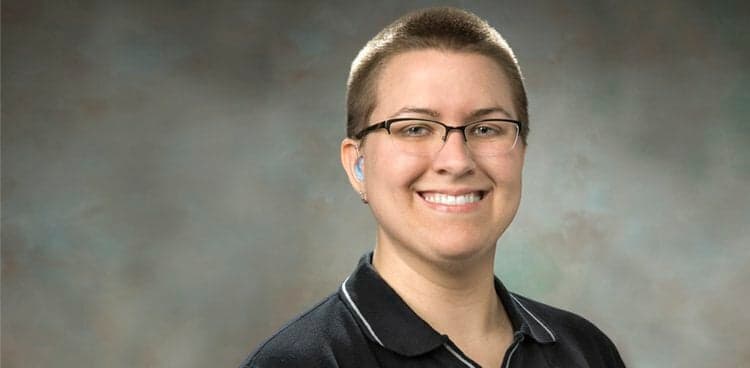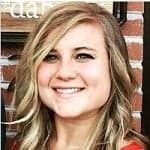Johanna Lucht grabbed two donuts on the way to her station in mission control at NASA’s Armstrong Flight Research Center. That day—April 4, 2017—was a big one for her and she could use the sustenance. Then the avionics systems engineer settled into her seat.
She and the rest of the control center team performed their “Day of Flight” procedure, in which they make sure all systems are good to go, establish secure communication between the control room and the aircraft, and check off everything else on their flight preparation list.
After the plane—a NASA Gulfstream III—took off, Lucht kept her eyes glued to the monitors in front of her. The bright screens were filled with data and graphs that informed her of every move the aircraft made.
There was one monitor she had that others in the room did not. “You will have to watch me eat donuts throughout the flight test,” she’d joked to test the video stream connection when she first sat down. Appearing remotely from NASA’s Langley Research Center in Virginia, the interpreter on the other end was there to relay all spoken communication in American Sign Language (ASL) for Lucht, who is deaf.
So, not only was it her first day playing an active role in a NASA control center during a crewed research flight—and the first time a NASA aircraft was flying with a “twisted wing flap configuration”—but it was also the first time a deaf engineer had ever taken on that responsibility.
Lucht’s success in her career isn’t something her family would’ve predicted during the first several years of her life. As a child, she didn’t have any access to language, which prevented her not only from communicating with others, but also from reading. School was really tough. At the age of nine, though, this all changed—her school brought in an interpreter, Keith Wann, to teach her ASL.
Before that, she shares, “I remember feeling overwhelmed with raw, extreme frustration whenever I struggled to communicate, to the point that I cried.”
Learning ASL wasn’t easy. After all, Lucht was starting from scratch. In the beginning, Wann simply focused on forming a connection with her and earning her trust. And it worked. Just a few months after their lessons began, Lucht could carry on full conversations for the first time. Her new knowledge of ASL allowed her to learn English and gave her access to education. Lucht went from a struggling and discouraged student to one who graduated high school with a 3.98 GPA.
Growing up as the only deaf person in her family was difficult. But Lucht believes it helped shape her into a resilient, patient individual. Plus, living with a hearing family meant she was exposed to hearing culture very early on in life, so she was able to experience (and overcome) a lot of challenges, such as the emotional turmoil of being excluded from conversations.
Despite it all, Lucht has always been a curious and hard-working person. While she still experiences some obstacles with language access today—online video and streaming, for example, are often severely lacking in supplemental written content—learning ASL and later English opened up her world.
Within about a decade of her language breakthrough, she was studying computer science at the University of Minnesota. One day during her junior year, she received an email about a NASA internship. But she didn’t go for it right away. In fact, she didn’t apply until she got the email for the third time.
“I hesitated to apply at first because I didn’t think I had a chance of getting into NASA,” she explains. “Today I want to smack my past self for not applying until the third email, but I’m glad it all worked out well.”
Worked out well is quite the understatement, as the internship—which she landed—eventually led to a full-time job. When she returned to school and began her job search ahead of graduation, she asked her former NASA mentor if she knew of any openings. A few months later, she got an offer to come back as an engineer in the Sensors and System Development department. After two years in that role, she transferred to the Flight Instrumentation and Systems Integration branch, where she still works today.
“When I first got here, I had no background in aeronautics, so I was pretty lost as far as terminology for a good while,” Lucht shares. “Fortunately, one of my favorite aspects of this job is that people around here are always willing to find time to answer my infinite list of questions,” she adds. And “not only were they helpful, but they also have an excellent sense of humor.”
As Lucht looks back, she realizes just how far she’s come—from a language-deprived child to a successful engineer who plays an integral role in NASA missions. “It’s difficult to describe my feelings,” she says, though when she tries, she explains that she’s in awe and feels validated.
She’s also more motivated than ever. “When the flight was over, all I could think about was where I should study up to become even more familiar with things I saw during my control room experience and to become better engineer.”
What Motivated Her to Become the First
When I saw the control room during my early days at NASA, I pictured myself there, in the seat, monitoring data and communication, and where the interpreter would be placed.
In 2016, the system lead asked if I wanted to sit in the “System 2” seat and, if so, what accommodations I would need. I was surprised—I’m used to asking hearing people to give me a chance. But this time, it was a hearing person asking me. The system lead knew that trying something new, especially if it’s a challenge, always motivates me, so it wasn’t hard to get a resounding “Yes!” out of me.
We actually didn’t even know at the time that I’d be the first Deaf engineer in this role. We only discovered this fact after our public affairs officer asked around at NASA.
The Biggest Challenge She Faced
For some of my co-workers, it was the first time they met and worked with a Deaf person. They weren’t immediately sure how to work with me, and some were afraid to ask questions about anything deaf-related. This definitely can make teamwork challenging at first, and it took a bit to get the ball rolling. This is one of the reasons I started giving the presentation “How to Work with Deaf People for Dummies,” which seemed to help people relax a little.
The best thing hearing allies can do is just listen. Deaf people often know their needs way better than hearing people ever can. I was fortunate to have close hearing allies who asked questions, listened, and attempted to persuade those who didn’t listen to me. I also wish that some people who decided to ask deaf-related questions to hearing people instead of me had known they could just ask me. They’re missing out on meeting an awesome, patient Deaf person.
Advice She’d Give Another First
Stay humble, but do share your success story with kids and other adults. When kids see that there are adults like them doing cool stuff, it can often inspire them. It shows that it’s more than possible for them to achieve great things.

